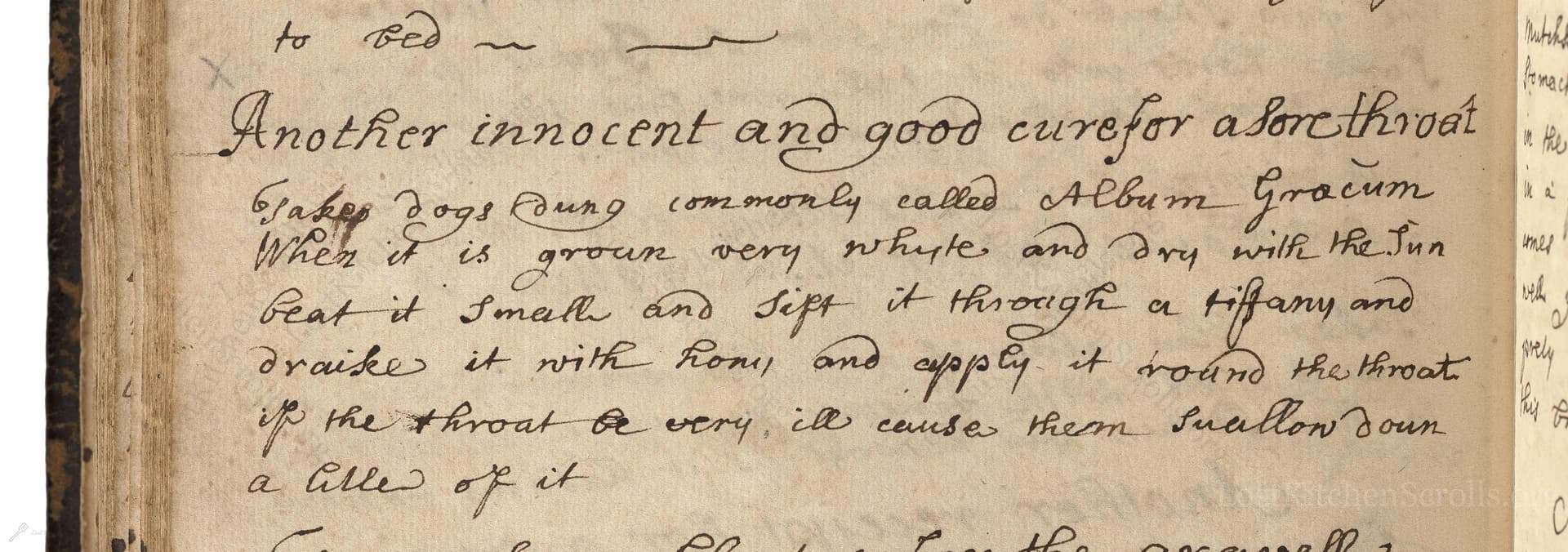Another Innocent And Good Cure For A Sore Throat
From the treasured pages of Cookbook
Unknown Author

Another Innocent And Good Cure For A Sore Throat
"Take Dogs dung commonly called Album Graecum when it is grown very whyte and dry with the Sun Beat it Small and Sift it through a tiffany and braise it with Honi and apply it round the throat if the throat be very ill cause them Swallow doun a litle of it"
Note on the Original Text
This recipe is written in the concise, imperative style typical of the early 1700s: instructions are direct, omissions are expected to be filled in by experienced caretakers, and precise measurements are generally lacking. Spelling follows period conventions ('honi' for honey, 'braise' for mix/spread), and clarity relies heavily on context and contemporary medical knowledge—a far cry from today's detailed, standardized recipes.

Title
Cookbook (1706)
You can also click the book image above to peruse the original tome
Writer
Unknown
Era
1706
Publisher
Unknown
Background
Step back to the early 18th century with this charming culinary collection, brimming with period recipes that tantalize the tastebuds and offer a delicious glimpse into historic kitchens.
Kindly made available by
Folger Shakespeare Library
This recipe comes from early 18th-century England, specifically around 1706, a time before antibiotics when cures for sore throats were largely home-based and often relied on ingredients thought to balance or purge the body’s humors. It reflects the medical beliefs of the era — favoring natural substances, even the most unexpected ones, for their presumed healing properties. 'Album Graecum' (sun-bleached dog dung) was used medicinally in both internal and external remedies throughout Europe in the Early Modern period.

The tools likely included a mortar and pestle to crush and grind the dried dung (or substitute), a fine sieve or cloth (called 'tiffany') to sift the powder, and a small bowl and spoon for mixing it with honey. For application, a finger or linen cloth would serve to spread the paste around the patient's throat.
Prep Time
5 mins
Cook Time
0 mins
Servings
2
We've done our best to adapt this historical recipe for modern kitchens, but some details may still need refinement. We warmly welcome feedback from fellow cooks and culinary historians — your insights support the entire community!
Ingredients
- 0.35 oz dried, white (sun-bleached) dog dung (modern substitute: 0.35 oz food-grade chalk powder)
- 0.7 oz honey (runny)
Instructions
- To recreate this historic remedy in a modern context, take dried white dog dung (nowadays, this ingredient is understandably not used; a safe substitute might be food-grade chalk for demonstration).
- Pulverize about 0.35 ounces until it becomes a fine powder, then sift the powder through a fine mesh or muslin to remove any lumps.
- Mix the sifted powder with 0.7 ounces of runny honey to create a thick paste.
- Apply the paste externally in a thin layer around the throat.
- For internal use, as the original suggests, one would traditionally swallow a very small amount (less than 0.04 ounces mixed with honey), but this is not recommended today for safety reasons.
Estimated Calories
22 per serving
Cooking Estimates
Pulverizing and sifting the powder takes a couple of minutes. Mixing it with honey to form a paste is quick. No cooking is needed. One serving is about 1 teaspoon of paste.
As noted above, we have made our best effort to translate and adapt this historical recipe for modern kitchens, taking into account ingredients nowadays, cooking techniques, measurements, and so on. However, historical recipes often contain assumptions that require interpretation.
We'd love for anyone to help improve these adaptations. Community contributions are highly welcome. If you have suggestions, corrections, or cooking tips based on your experience with this recipe, please share them below.
Join the Discussion
Rate This Recipe
Dietary Preference
Main Ingredients
Occasions

Den Bockfisch In Einer Fleisch Suppen Zu Kochen
This recipe hails from a German manuscript cookbook compiled in 1696, a time whe...

Die Grieß Nudlen Zumachen
This recipe comes from a rather mysterious manuscript cookbook, penned anonymous...

Ein Boudain
This recipe comes from an anonymous German-language manuscript cookbook from 169...

Ein Gesaltzen Citroni
This recipe, dating from 1696, comes from an extensive anonymous German cookbook...
Browse our complete collection of time-honored recipes



